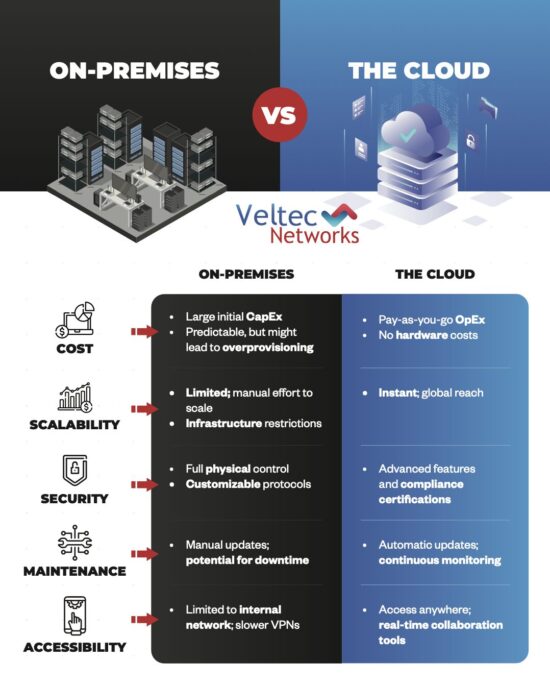Downtime is Bad for Business.
Whether you agree or not, it’s a fact – Ponemon Institute estimates that every minute of even partial downtime can cost as much as $5,600.
Why Does Downtime Cost So Much?
The main cost of downtime is not the fix itself, it’s the halt in your business’ productivity. If an IT-related or natural disaster occurs and takes critical systems offline, employees will be unable to complete their tasks, yet your normal business expenses will carry on.
Downtime Costs You Can Measure
The economy of downtime is unforgiving – it grinds your business to a halt, racks up expenses, and keeps you from getting anything done.
- Expense Vs. Revenue: During downtime, you incur all the expenses of running a business without the revenue you would usually generate.
- Loss of Focus: Even if downtime does not grind everything to a halt, some of your staff will have to divert themselves from their normal work to mitigate the problem – again reducing productivity.
- Affected Service Delivery: Furthermore, while your systems are down, you can’t deliver services or sell products to current and potential new clients.
- Cost Of Repair: However you approach fixing the problem, it’ll cost time and money.
Downtime Costs You Can’t Measure
Not all of the costs associated with downtime have a tangible price tag:
- Reputational Damage: The trust of your clients and the reputation of your company are invaluable assets that can erode with prolonged or frequent downtime issues. A diminished reputation can negatively affect your future business opportunities.
- Organizational Culture: The more downtime you experience, the worse your employees’ moods will be. The longer they’re stuck waiting around to do their work, the more frustrated they’ll get, and the less highly they’ll think about the way your business operates.
- Stunted Growth: If you’re always “putting out fires”, how can you ever expect to move forward? IT projects and expansions will continually be put on the back burner because of more pressing (yet, smaller scale) problems.
What Are The Primary Causes Of Downtime?
- Power Outage: If your power source fails, that can lead to a long list of complications like servers going down and lost, unsaved data.
- Cybercrime: Cybercrime has increased in recent years and is still on the rise. All it takes is one employee opening a malicious attachment and your business data could be held hostage.
- Human Error: Accidentally unplugging key equipment, overloading the system, and improper installations can all cause downtime, but maintaining certain policies and procedures can cut down on human error.
- Natural Disasters: Hurricanes, tornadoes, floods, and earthquakes happen. Having a plan for getting back to business if the unthinkable happens is the fastest way to recover.
Some downtime is inevitable, but much of it can be prevented and mitigated.
What’s The Best Way To Prevent Downtime?
…by stopping it in the first place. Or as much of it as you can.
Let’s be clear – no business can guarantee absolutely zero downtime. Even Microsoft and Amazon only offer a 99.9% uptime guarantee, because they know that it will never be perfect.
Part of the process of avoiding as much downtime as possible comes from recognizing its inevitability. With that understanding, you can then work to mitigate its common causes.
- Backups: Can you stand to lose a week’s worth of data? If the answer is no then you’ll need to run backups more often. Take into account how long you can go without certain data. Restoring backups can take time and ‘file-level’ backups can take longer to recover than ‘image-level’ backups. Make sure your backups are also stored at an offsite location.
- Business Continuity Planning: This involves risk mitigation planning and business recovery planning. Risk mitigation should reduce the possibility of adverse events while business recovery planning helps ensure continued operation in the event of a server failure or natural disaster. Take into account the mission-critical data and systems your business needs to do its basic functions and prioritize them. A business continuity plan should be a ‘Plan B’ for how virtually every aspect of your business operates.
- Test Your Processes: The worst time to find out there is a problem recovering backups is when you really need them. Verify your backups periodically.
The best way to approach downtime prevention is proactively – you need to keep an eye out for system issues that can spiral into total stoppages. You need to implement backup technologies and best practices to prevent outages. You need to enhance your cybersecurity to protect against cybercrime.
Unfortunately, that’s a lot for you to handle on your own, especially when you have other work to see to. That’s why a managed IT services company can be so helpful. They’ll provide 24/7 active monitoring of your systems, business continuity best practices and cybersecurity services that will keep costly downtime at a minimum.
Like this article? Check out the following blogs to learn more:
How Are Face and Touch Recognition Changing iCloud Access?






